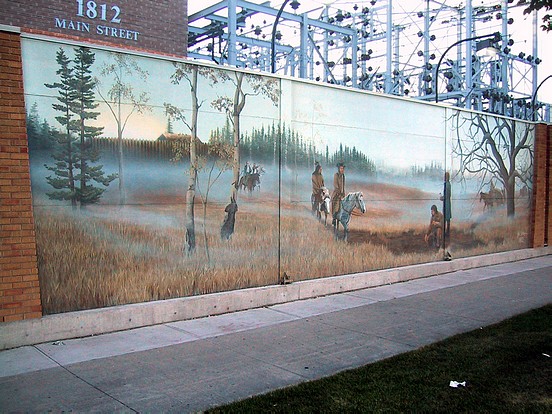|
|
|
|
|
|





|
|
1812 Main Street (2)
Location Map

Scene of 1812.
|
Location: SW corner Main & Semple; East Face
Occupant: Manitoba Hydro substation
District: West Kildonan
Neighbourhood: Jefferson
Artist(s): Jill Sellers (Jill Sellers Design)
Year: 2001
Sponsors: Manitoba Hydro
|
|
|
Jill Sellers: "The second scene, set in 1812 presents was more of an eerie uneasiness and
unsettled feeling, with confrontation about to happen." Jill 's use of the low-lying fog
was a deliberate effort to visually evoke a dramatic eeriness about the scene. A
representation of Fort Gibraltar, the Northwest Company (NWC) post can be seen at the
top left. There is a portraiture of William McGillivray, chief director of the NWC (on
horseback, centre of scene) and he's accompanied by one of the Metis trappers (also on
horseback) who worked closely with the NWC and brought supplies to the Nor'Westers.
The figure in the blue is a representation of Miles Macdonell, whom Lord Selkirk had
appointed as first Governor of Assiniboia. He's holding a copy of the proclamation that
they were there to formally take possession of the land in Lord Selkirk's name. The man
with him kneeling is grabbing and feeling the dirt and checking it out for farming. The
Selkirk or Red River Settlers were affiliated with the Hudson's Bay Company (HBC) and
brought over by them. The scene aptly conveys the uneasiness of the Northwesterners
as Selkirk's settlers arrive from the right side.
There is a little mouse hidden in scene two. Sellers put a mouse in the scene for a few of
her regular visitors that would come to visit her at the site. It was Jill's way of thanking
them for their visits and to provide them with something engaging to do while they were
there. (Editor's note: It's there; I found it too!)
Historical backstory: The Red River Colony was a colonization project set up
by Thomas Selkirk, the 5th Earl of Selkirk in 1811 on 160,000 square miles (300,000
square kilometres) of land granted to him by the HBC.
Lord Selkirk was born as Thomas Douglas in Scotland in 1773, the youngest of
seven children, and was educated as a lawyer. He outlived all of his older brothers, and
thus inherited his fathers' wealth and title when he died. At that time there was much
social upheaval in Scotland: many Scottish peasants, or 'Crofters', were losing their
homes because landowners found it more profitable to raise sheep on their land, rather
than rent it to tenants. Unlike most other wealthy noblemen, Selkirk took an interest in
them and felt that he could help them. He had been inspired by Alexander MacKenzie's
1801 book describing MacKenzie's adventures in exploring Western Canada. Selkirk
decided to settle the poor people in British North America to give them a better life.
To acquire the land needed to colonize in B.N.A. (British North America), Lord Selkirk
bought enough shares from the HBC to give him controlling interest in the company. In
doing that, he was granted 160,000 square miles of land called Assiniboia, as the HBC
had charter to the land dating back to 1670. The land included the watersheds of the Red
and Assiniboine rivers, up to Lake Winnipeg, covering areas in what is today southern
Manitoba and northern North Dakota. He sent poor Irish and Highland Scots from the
British Isles to B.N.A. to start colonizing the Red River Valley.
His plan was to gain firm control of the area in order to take control of the west from his
company's bitter rivals, the Montreal based NWC. With a colony in place the Metis
trappers supplying the North West's fur traders, the Nor'westers, would be displaced,
cutting them off from areas further west.
Miles Macdonell was chosen by Lord Selkirk to be his agent in the
establishment of the Red River Colony and he was appointed the first Governor of
Assiniboia. Macdonell was sent to Ireland where he persuaded more peasants to
immigrate to the Red River Valley. When they arrived in 1812 they built a fort, Fort
Douglas, but by the time it was done the growing season was over and they hastily set
about hunting buffalo for food.
When farming started the next spring, the results were less than expected and Selkirk had
to ban anyone from taking food out of the colony. In fear of starvation of his colony ,
Macdonell issued a declaration in 1814 forbidding the export of pemmican from
Assiniboia. The already hostile Metis and North West Company officials took this
Pemmican Proclamation as a declaration of war, because this would cut off the
Nor'westers, who relied on pemmican supplied to them by local Metis.
And so began a desperate struggle for control of the west and the western fur trade, with
Lord Selkirk orchestrating the HBC's activities, and William McGillivray orchestrating
the NWC's activities.
William McGillivray was born in Scotland and brought to Montreal in 1784 by
his uncle Simon McTavish of McTavish, Frobisher and Company. McGillivray spent a
number of years learning the business. He set up western trading posts and competed
with rival companies. In 1790 he was made a partner in the NWC; a year later he was put
in charge of the Athabasca Department, a huge territory that was the richest source of furs
in North America On McTavish's death in 1804 McGillivray became the company's
chief director. Fort William, the company's headquarters on Lake Superior, was named in
his honour in 1807. McGillivray commanded a company of voyageurs in the War of
1812, assisting Isaac Brock at the capture of Detroit. In recognition of these services he
was appointed to the legislative council of Lower Canada in 1814. He directed the
NWC's opposition to the Red River Settlement by his bitter rival; and used his position
as western advisor of the governor of Lower Canada to prevent any Canadian
government intervention in the dispute with Selkirk and HBC.
|
|